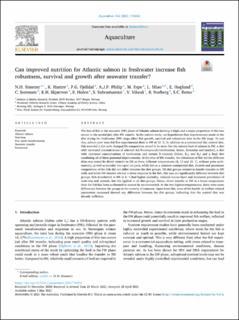| dc.description.abstract | The loss of fish in the seawater (SW) phase of Atlantic salmon farming is high, and a major proportion of this loss occurs in the period just after SW transfer. In the current study, we hypothesize that improvements made to the diet during the freshwater (FW) stage affect fish growth, survival and robustness later in the SW stage. To test this, salmon parr were fed five experimental diets in FW at 12 °C. In addition to a commercial-like control diet, fish were fed a diet with changed FA composition aimed to be more like the natural feed of salmon in FW, a diet with increased concentrations of selected AA/N-compounds (methionine, lysine, threonine and taurine), a diet with increased concentrations of methionine and certain B-vitamins (folate, B12 and B6) and a final diet combining all of these potential improvements. At the time of SW transfer, the robustness of fish fed the different diets was tested by direct transfer to SW at three different temperatures (8, 12 and 16 °C, without prior acclimation), as well as transfer into open net pens, while fed on a common commercial diet. Growth and proximate composition of the fish did not differ between the diet groups. All diet groups seemed to handle transfer to SW well, and while SW transfer elicited a stress response in the fish, this was not significantly different between diet groups. Fish transferred to SW at 8 °C had higher mortality, reduced mucus layer and increased prevalence of scale loss and wounds, but this applied to all diet groups. Hence, direct transfer to SW at a lower temperature than the fish has been acclimated to cannot be recommended. At the two highest temperatures, there were some differences between the groups in the severity of cataracts. Apart from this, none of the health- or welfare related parameters measured showed any difference between the diet groups, indicating that the control diet was already sufficient. | |
